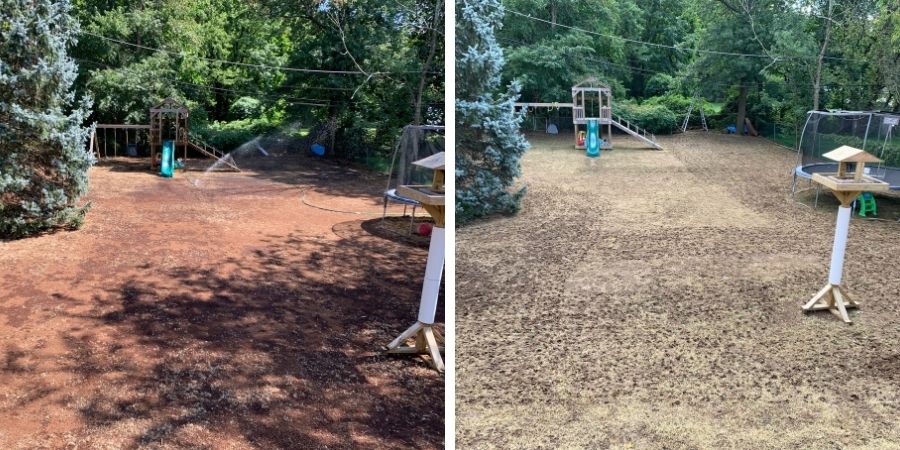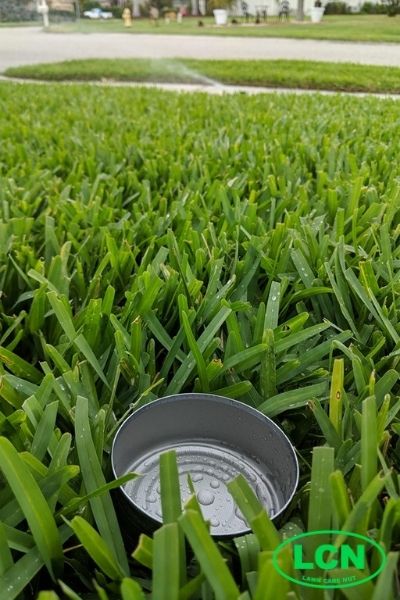Summer Lawn Care for Beginners
- Milorganite AgronomistJune 26, 2021
Lawn maintenance for beginners shouldn’t be a struggle—it’s a learning experience. Here are the most important summer lawn maintenance tips for beginners. I’ve included both what should be done, as well as why it’s important to the health of your lawn.
Matthew of Abington, Pennsylvania, quickly learned that he was going to get the best results by learning about lawn care and doing the work himself to achieve the lawn he wants for his family. “We had lawn care service for about four years with little to no results. I started watching your content just before our COVID-19 stay-at-home time, which inspired me to cancel my lawn care service and get to know my turf.”

Matthew taking lawn care into his own hands during his renovation.
Learn these lawncare tasks and you’ll quickly go from a lawn care beginner to an expert.
Lawn Detective Work
Part of your lawncare apprenticeship is to be able to identify problems, which can include issues caused by weather, heavy traffic, dogs, pests, and diseases. It’s a learn-as-you-go education. With any apprenticeship, you’re not going to know everything on day one.
Keep a Lawn Care Schedule, Take Notes
On your journey to becoming a seasoned lawncare homeowner, it’s good to keep an annual lawn care schedule. Keep a notebook and pen in your garage or shed. It will help you both remember what you’ve already done, as well as provide a place for notes. Jot down any diseases or pests, or other problems you’ve encountered or treated and when. It will be something to look for next year at the same time.
A fertilization schedule can be particularly important in communities with fertilization ordinances. You’d hate to miss an application by only a couple weeks! Check local ordinances for fertilizer blackout dates.
One of the first things Matthew did was created a map of his yard. This could come in handy to keep track of lawn maintenance that has been or needs to be done, as well as problem areas.
Get Your Soil Tested
A soil test will provide a wealth of important information that will help you create healthy soil. You don’t have to do it yourself. I don’t recommend store-bought soil test kits, because they aren’t very accurate. Instead, contact your local university extension service about soil testing services they offer. They’ll walk you through the process of collecting samples.
The soil analysis will indicate the composition of the soil, whether your lawn needs more or less nitrogen and if other amendments are needed, among other useful information.
Watering During Average and Drought Conditions
Your lawn will benefit from being watered deeply and infrequently. Frequent, light watering can damage lawns by encouraging shallow root growth.
Lawns need about an inch of water every week. Keep an eye on how much rain has fallen and irrigate to make up the difference.
If you’re relying more on irrigation than rain, measure how much water you’re applying. Use a tuna can or other similar flat container and set it out when you water your lawn. When there’s one inch of water in the container, you’ve watered 1 inch. Take note of how long it took. That way, you’ll know how long to water next time without having to measure.
Your goal is to keep the top 4 to 6 inches of soil damp. You can use a 6-inch screwdriver to determine the depth of moisture. Insert it into the soil; you’ll feel resistance when it reaches dry soil. Use this method before irrigating to determine how much water your lawn needs, if any. After irrigating, check to see how deep the water has reached. Consider testing in a few locations to see if the lawn is being watered evenly.
The time of day you water your lawn is important. Water lawns early in the morning to allow the grass to dry. Grass that remains wet for an extended period of time is more susceptible to disease. More water will also evaporate when irrigating mid-day in the heat and sun.
Extended periods of heat and drought can cause lawns to go into dormancy, taking up less water and causing growth to stop. Lawns can survive drought-induced dormancy for 3–4 weeks without water.
You have a choice to make if your lawn has gone into drought-induced dormancy and, once you make it, you have to stick to it. 1.) You can keep your lawn alive during periods of drought, but not actively growing, or; 2.) you can continue to water up to 1 inch weekly. My personal preference is to keep the lawn alive. It uses less water and the lawn will green up again when conditions are right.
If you choose to maintain the dormant lawn, only water every 3–4 weeks at a rate of ½ to 1 inch. This will help your lawn survive the heat. You must be consistent! A varied watering schedule adds stress to your lawn. Your goal here is to simply keep it alive.
If you decide you’d rather keep your lawn green and growing, maintain a watering schedule of ½ inch twice a week or to 1 inch once a week. Again, you have to be consistent to avoid stressing your lawn even more.
Mow High, Mow Often
Lawn health is directly impacted by mowing height. In general, the height of the grass is an indicator of root depth: taller grass, deeper roots. The higher you mow, the healthier the lawn.
We’re already experiencing drought conditions here in Wisconsin. I see lawns that have been mowed too low and they’re fried. Mowing at the highest recommended height is especially important in summer drought conditions. Longer grass and deeper root systems are better able to survive drought. It helps prevent soil from drying out and also keeps weed seeds from growing.
To determine the correct mowing height, you first need to identify the variety of grass in your lawn. Each variety has a different optimum height.
Never remove more than 1/3 of a blade of grass at a time when you mow. If the grass is really long, you may have to mow a few times over several days to reach the recommended height.
Alternate the direction each time you mow to help prevent ruts from forming. Leave grass clippings on the lawn. It’s free fertilizer.
You may need to have your mower blade sharpened mid-season. Here you’ll find more lawn mowing tips that should also be helpful.
Weed Control
The best form of weed control during the summer is to remove them by hand. I prefer this method because it reduces the number of chemicals I use on my lawn. Or you could choose to spot treat weeds using a post-emergent (the weed is already growing) herbicide.
If your lawn has more weeds than pulling or spot treating will solve, you’ll have to wait until fall to throw down a post-emergent herbicide or apply a weed and feed product. Here’s more information on applying weed and feed products.
If you’re in a location where winter weeds invade your lawn, plan on applying a pre-emergent herbicide in fall, which helps to prevent weed seeds from growing. (Add it to your schedule so you don’t forget.)
Fertilize Northern, Cool-season Grasses
Fertilizer should be applied to an established lawn when the grass is actively growing. If you live in the North you have cool-season grasses. Plan on fertilizing with Milorganite around July 4. Use our “holiday schedule,” which indicates the best times to fertilize both cool-season and warm-season grasses with Milorganite. If you have warm-season grass varieties, you’ll have to wait until Labor Day to fertilize.
Milorganite is a slow-release nitrogen fertilizer. It provides your lawn with nutrients, at a rate it can use, for 8–10 weeks. It contains iron, which helps keep the lawn green. It’s not necessary to water in Milorganite, however, watering will ensure the fertilizer is in contact with the soil and speeds up the fertilization process.
Milorganite is non-burning, which is particularly helpful to lawncare beginners. Synthetic fertilizers can easily burn lawns, causing brown stripes or areas of dead, brown grass. That will never happen when you use Milorganite. It can even be applied in hot, dry weather because nutrients are only available to the lawn when conditions are right for the grass to grow.
Apply Milorganite at the suggested rate to help prevent nutrient runoff, which can be detrimental to waterways and aquatic life. Too much nitrogen can also weaken lawns by encouraging blade growth over root growth. (Yes, you can have too much of a good thing.) Always maintain a 10-foot buffer—the no-fertilize zone—adjacent to any body of water to further prevent runoff.
Before applying Milorganite or any other lawn product, it’s a good idea to calibrate your spreader to ensure you’re really applying the amount of product you assume you are. We’ve provided spreader settings for some of the more common spreaders. If your brand of spreader isn’t listed, you can calibrate any spreader in just a few steps.
Repairing Bare Spots, Seeding
Summer is not the time to repair bare spots, overseed your lawn, or start a new lawn from seed. The best time of year to seed is late summer or early-fall. If it’s still very hot in late-summer, wait until the weather cools off in early-fall. Add seeding to your schedule for later in the year.
Lawncare for beginners doesn’t have to be overwhelming. Staying on schedule—consistency—is one of the most important aspects of maintaining a healthy lawn, no matter what the task may be.


